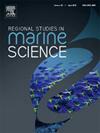Unveiling hidden threats: Assessing the risks of potentially toxic elements (PTEs) in contaminated fish of the Anzali Wetland
IF 2.1
4区 环境科学与生态学
Q3 ECOLOGY
引用次数: 0
Abstract
The environmental degradation caused by potentially toxic elements (PTEs) and its consequential health risks to humans and the environment have raised profound concerns. To explore the potential hazards associated with PTEs, we analyzed the total concentration of As, Cd, Cr, Hg, and Pb in the muscle, gills, viscera, and eggs of four fish species Esox lucius Linnaeus, 1758 (Pike), Cyprinus carpio Linnaeus, 1758 (Carp), Vimba vimba Linnaeus, 1758 (Vimba), and Tinca tinca Linnaeus, 1758 (Tinca) collected from the Anzali Wetland. We measured the concentrations of trace metals in the fish samples and calculated the associated human health risks and compared the results with the international standards. Our findings showed the PTEs concentrations in fish samples with Cr > Hg > Pb > Cd >As. We observed Cr, Hg, and Pb concentrations (3.4 ± 1.61, 2.57 ± 1.24, and 1.7 ± 0.48 μg g−1 wet weight (w.w.), respectively) in muscle samples, Cd concentration (1.05 ± 0.53 μg g−1 w.w.) in eggs, and As concentration (0.40 ± 0.13 μg g−1 w.w.) in viscera of Pike. Consequently, Pike exhibited the highest concentrations of these metals across all its sampled tissues. Comparing the results to the standard set by the World Health Organization (WHO) declared that the average heavy metal concentrations exceeded the permissible limits for certain elements. Results also indicated that the concentrations of As and Pb in all fish species posed potential health risks, particularly to children, with a target hazard quotient THQ> 1. Moreover, the presence of As and Pb metals in all human age groups, as well as Cr and Hg metals, indicated a potential risk of cancer for children (Cr > 1E-4). Therefore, the metal pollution status of the Anzali Wetland not only influences the biodiversity of fish but potentially poses health-related issues to the target consumers.
揭示隐藏的威胁:评估安扎利湿地受污染鱼类中潜在有毒元素 (PTE) 的风险
潜在有毒元素(PTEs)导致的环境恶化及其对人类和环境造成的健康风险引起了人们的深切关注。为了探究潜在有毒元素的潜在危害,我们分析了从安扎里湿地采集的四种鱼类:林尼厄斯-1758(梭鱼)、林尼厄斯-1758(鲤鱼)、林尼厄斯-1758(温巴鱼)和林尼厄斯-1758(丁卡鱼)的肌肉、鱼鳃、内脏和鱼卵中的砷、镉、铬、汞和铅的总浓度。我们测量了鱼类样本中的痕量金属浓度,计算了相关的人类健康风险,并将结果与国际标准进行了比较。我们的研究结果表明,鱼类样本中的 PTEs 浓度为 Cr > Hgt > Pb > Cd > As。我们在梭子鱼肌肉样本中观察到铬、汞和铅浓度(分别为 3.4 ± 1.61、2.57 ± 1.24 和 1.7 ± 0.48 μg g-1 湿重),在鱼卵中观察到镉浓度(1.05 ± 0.53 μg g-1 湿重),在内脏中观察到砷浓度(0.40 ± 0.13 μg g-1 湿重)。因此,梭子鱼所有采样组织中这些金属的浓度最高。将结果与世界卫生组织(WHO)规定的标准进行比较后发现,重金属的平均浓度超出了某些元素的允许限值。结果还表明,所有鱼类物种中的砷和铅浓度都对健康构成了潜在风险,尤其是对儿童而言,其目标危害商数为 THQ>1。此外,所有年龄组的人体内都存在砷和铅金属,以及铬和汞金属,这表明儿童有患癌的潜在风险(铬>1E-4)。因此,安扎利湿地的金属污染状况不仅影响鱼类的生物多样性,还可能对目标消费者的健康造成影响。
本文章由计算机程序翻译,如有差异,请以英文原文为准。
求助全文
约1分钟内获得全文
求助全文
来源期刊

Regional Studies in Marine Science
Agricultural and Biological Sciences-Ecology, Evolution, Behavior and Systematics
CiteScore
3.90
自引率
4.80%
发文量
336
审稿时长
69 days
期刊介绍:
REGIONAL STUDIES IN MARINE SCIENCE will publish scientifically sound papers on regional aspects of maritime and marine resources in estuaries, coastal zones, continental shelf, the seas and oceans.
 求助内容:
求助内容: 应助结果提醒方式:
应助结果提醒方式:


